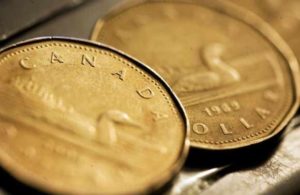 Yesterday’s trade saw USD/CAD within the range of 1.2941-1.3134. The pair closed at 1.2989, falling 0.83% on a daily basis. It has been the 26th drop in the past 53 trading days and also a second consecutive one. The daily low has been the lowest level since October 20th 2015, when a low of 1.2931 was registered. USD/CAD has extended losses to 3.98% of its value so far during the current month.
Yesterday’s trade saw USD/CAD within the range of 1.2941-1.3134. The pair closed at 1.2989, falling 0.83% on a daily basis. It has been the 26th drop in the past 53 trading days and also a second consecutive one. The daily low has been the lowest level since October 20th 2015, when a low of 1.2931 was registered. USD/CAD has extended losses to 3.98% of its value so far during the current month.
At 7:41 GMT today USD/CAD was edging up 0.15% on the day to trade at 1.3009. The pair touched a daily high at 1.3011 at 7:21 GMT, overshooting the daily R1 level, and a daily low at 1.2969 during early Asian trade.
Canada’s dollar reached fresh 5-month highs against its US counterpart on Thursday, as crude oil futures recorded highs unseen since early December 2015. March 17th marked the 34th gain in oil prices out of the past 65 trading days and also the second consecutive one. Oil futures for April delivery went up as high as $40.54 per barrel on March 17th, or the highest price level since December 4th, and closed at $40.12, climbing 4.32% on the day. As of 7:47 GMT today the commodity was edging down 0.17% on a daily basis to trade at $40.05 per barrel, after going down as low as $40.02 earlier.
On Friday USD/CAD trading may be influenced by the following macroeconomic reports as listed below.
Fundamentals
United States
Reuters/Michigan Consumer Sentiment Index – preliminary reading
The monthly survey by Thomson Reuters and the University of Michigan may show that consumer confidence in the United States improved in March. The preliminary reading of the corresponding index, which usually comes out two weeks ahead of the final data, probably rose to 92.2 during the current month from a final reading of 91.7 in February. The latter came well above the preliminary reading of 90.7, which was reported on February 12th. If expectations were met, Marchs reading would be the highest since December 2015, when a level of 92.6 was reported.
The sub-index of current economic conditions advanced to a final reading of 106.8 from a preliminary 105.8 in February, and also up from a final 106.4 in the preceding month.
The sub-index of consumer expectations came in at a reading of 81.9, up from a preliminary value of 81.0 in February, but down from a final reading of 82.7, registered in January.
Participants in the February survey expected that the rate of inflation will be at 2.5% during the next year, or matching the rate in the preliminary release and also the one in the January survey.
In case the gauge of consumer sentiment increased at a steeper pace than projected in March, this would have a moderate-to-strong bullish effect on the greenback. The preliminary reading is due out at 14:00 GMT.
Canada
Retail Sales
Retail sales in Canada probably rose 0.6% in January on a monthly basis, according to the median forecast by experts, following a 2.2% drop in the prior month. The latter has been the sharpest monthly drop since December 2008, when sales fell at a revised down rate of 5.4%. In December, sales at new car dealers went down 4.1% from a month ago, those of food and beverages dropped 1.2%, while sales at gasoline stations were 1.1% lower. On the other hand, sales at furniture and home furnishings stores went up 0.5% during the same month.
Retail sales, excluding sales of automobiles, probably rose 0.4% in January compared to December, following a 1.6% slump in the prior month. The latter has been the steepest monthly decline since January 2015, when core sales fell at a revised down rate of 1.8%. Large-ticket purchases are excluded due to their high volatility, which could influence the general trend. In case general retail sales rebounded at a faster rate than anticipated in January, this would have a moderate bullish effect on the Canadian dollar. Statistics Canada is to release the official report at 12:30 GMT.
Consumer Price Inflation
The annualized consumer inflation in Canada probably remained at 2.0% for a second consecutive month in February, according to market expectations. It has been the highest annual inflation since November 2014. In December 2015 annual consumer prices were reported to have risen 1.6%.
In January prices of food rose 4.0% year-on-year, following a 3.7% increase in the previous month. Consumers also paid more for transportation during the month (a 2.2% year-on-year increase, following a 0.6% rise in December). On the other hand, cost of clothing and footwear dropped 0.3% in January, following a 0.7% surge in December, according to the report by the Statistics Canada.
Bank of Canadas (BoC) annualized Core CPI, which excludes prices of fruits, vegetables, gasoline, fuel oil, natural gas, mortgages, intercity transportation, and tobacco products, probably remained at 2.0% for a second straight month in February. In December the annual core CPI rose 1.9%. This is the key measure of inflation, on which the central bank bases its decisions regarding monetary policy. In case both the general CPI and the core CPI came above expectations in February, this would have a strong bullish impact on the Canadian dollar. The official CPI report by the Statistics Canada is due out at 12:30 GMT.
Daily and Weekly Pivot Levels
By employing the Camarilla calculation method, the daily pivot levels for USD/CAD are presented as follows:
R1 – 1.3007
R2 – 1.3024
R3 (range resistance) – 1.3042
R4 (range breakout) – 1.3095
S1 – 1.2971
S2 – 1.2954
S3 (range support) – 1.2936
S4 (range breakout) – 1.2883
By using the traditional method of calculation, the weekly pivot levels for USD/CAD are presented as follows:
Central Pivot Point – 1.3274
R1 – 1.3383
R2 – 1.3557
R3 – 1.3666
S1 – 1.3100
S2 – 1.2991
S3 – 1.2817





